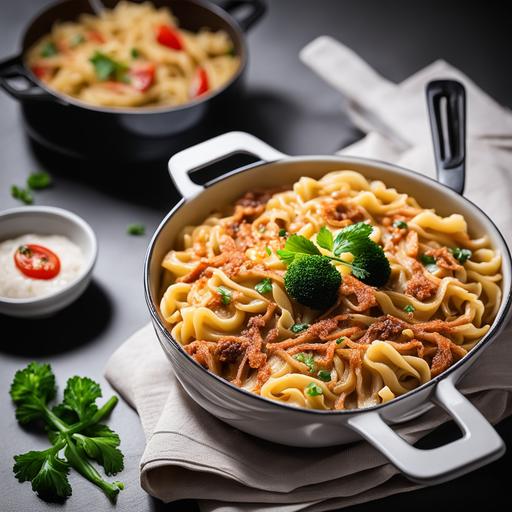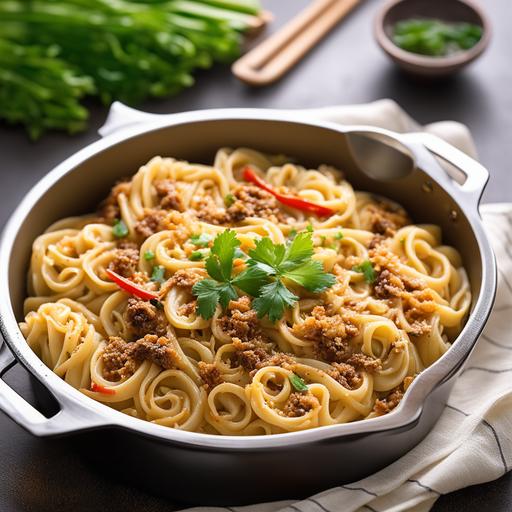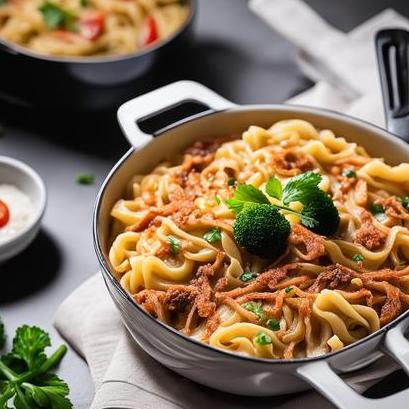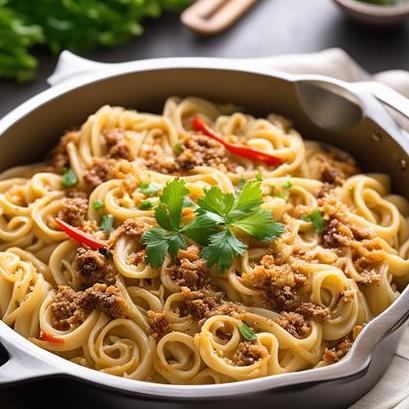
Noodles Oven Recipe: A Comprehensive Guide
Noodles are a versatile and beloved dish enjoyed by people all around the world. While they are traditionally cooked on the stovetop, using an oven to prepare noodles can offer a unique twist to this classic meal. In this article, we will explore the process of cooking noodles in an oven, from the science behind it to the step-by-step recipe for creating a delicious dish.
Food Science Of Cooking Noodles In An Oven
Cooking noodles in an oven involves a different heat distribution method compared to cooking them on a stovetop. Instead of direct contact with a heated surface, noodles in the oven are exposed to hot air, which cooks them evenly. The dry heat of the oven helps to evaporate moisture from the noodles, resulting in a firmer texture while still maintaining their tenderness.
Additionally, cooking noodles in the oven allows for greater control over the cooking process. By adjusting the temperature and cooking time, you can achieve the desired level of doneness and texture. This method also allows for the noodles to absorb flavors from other ingredients in the dish, resulting in a more flavorful end result.
Choosing Ingredients
When it comes to choosing ingredients for oven-cooked noodles, there are several factors to consider. Firstly, selecting the right type of noodle is crucial. While traditional pasta noodles like spaghetti or fettuccine work well, you can also experiment with different varieties such as rice noodles or soba noodles for a unique twist.
In addition to the noodles, you’ll need to choose complementary ingredients to enhance the flavor of the dish. This can include vegetables, proteins such as chicken or tofu, and seasonings like herbs and spices. Opting for fresh, high-quality ingredients will ensure a delicious and satisfying meal.
Preparing Ingredients

Before assembling your noodles for the oven, it’s important to properly prepare all the ingredients. This includes cooking any proteins you plan to include, chopping vegetables, and pre-cooking the noodles if necessary. For oven-cooked noodles, it’s best to slightly undercook the noodles during this step since they will continue to cook in the oven.
Once all the ingredients are prepared, you can begin assembling the dish. Depending on the recipe, you may layer the ingredients in a baking dish or mix them together in a bowl before transferring to a baking dish. Be sure to evenly distribute the ingredients to ensure even cooking throughout.
Optimal Oven Cooking Temperature & Timing
The optimal oven temperature and cooking time will vary depending on the recipe and the type of noodles you are using. In general, a temperature of around 375°F (190°C) works well for most oven-cooked noodle dishes. This temperature allows for thorough cooking without burning the ingredients.
As for cooking time, most oven-cooked noodle dishes will require around 20-30 minutes in the oven. However, it’s important to keep an eye on the dish and check for doneness periodically. The noodles should be tender but still slightly firm to the bite, and any proteins should be cooked through.
Noodles Oven Recipe
Ingredients
- 8 ounces (about 225 grams) of noodles (spaghetti, fettuccine, or your preferred type)
- 1 tablespoon of olive oil
- 2 cloves of garlic, minced
- 1 onion, diced
- 1 bell pepper, sliced
- 1 cup of sliced mushrooms
- 1 cup of cherry tomatoes, halved
- 2 cups of cooked chicken, shredded (optional)
- 1 teaspoon of dried oregano
- 1 teaspoon of dried basil
- Salt and pepper to taste
- 2 cups of marinara sauce
- 1 cup of shredded mozzarella cheese
Instructions
-
Preheat your oven to 375°F (190°C).
-
Cook the noodles according to the package instructions until they are slightly undercooked. Drain and set aside.
-
In a large skillet, heat the olive oil over medium heat. Add the garlic, onion, bell pepper, and mushrooms, and sauté until they are tender, about 5 minutes.
-
Add the cherry tomatoes, cooked chicken (if using), dried oregano, dried basil, salt, and pepper to the skillet. Cook for an additional 2-3 minutes, until the tomatoes are softened.
-
In a large bowl, combine the cooked noodles, vegetable and chicken mixture, and marinara sauce. Mix well to ensure that the noodles are evenly coated.
-
Transfer the noodle mixture to a greased baking dish. Sprinkle the shredded mozzarella cheese evenly over the top.
-
Cover the baking dish with aluminum foil and bake in the preheated oven for 20 minutes.
-
Remove the foil and bake for an additional 5-10 minutes, until the cheese is melted and bubbly.
-
Remove from the oven and let cool for a few minutes before serving. Garnish with fresh basil or parsley if desired.
Cooking noodles in the oven offers a unique and flavorful alternative to traditional stovetop methods. By understanding the science behind oven cooking and following a carefully crafted recipe, you can create delicious noodle dishes that are sure to impress. Whether you’re craving a classic spaghetti bake or a creative noodle casserole, the oven is a versatile tool that can help you achieve mouthwatering results every time.
Doneness Checks

Cooking noodles in the oven might seem unconventional, but it’s a technique that can yield delightful results. By baking noodles in the oven, you can achieve a satisfying texture that’s slightly crispy on the outside while remaining tender on the inside. Additionally, baking allows for even cooking throughout the dish, ensuring that every bite is infused with flavor.
Determining the doneness of noodles in the oven requires careful attention to detail. Here are some key indicators to look for:
-
Texture: The noodles should be cooked to the desired texture, whether you prefer them al dente or softer. Test a few noodles by piercing them with a fork or tasting them to gauge their doneness.
-
Color: Depending on the recipe, the noodles may develop a golden brown color on the edges when they are fully cooked. Keep an eye on the color of the noodles to avoid undercooking or overcooking.
-
Bubbling Sauce: If the noodles are baked in a sauce, such as a marinara or cheese sauce, the sauce should be bubbling gently around the edges of the dish. This indicates that the noodles are heating evenly and the sauce is melding with them properly.
-
Internal Temperature: For dishes containing meat or seafood, use a food thermometer to ensure that the internal temperature reaches a safe level for consumption, typically 165°F (74°C) for poultry and ground meats, and 145°F (63°C) for whole cuts of meat and seafood.
Undercooking
Undercooked noodles can ruin the texture and flavor of a dish, leaving it unpleasantly firm and crunchy. To avoid undercooking, follow these tips:
-
Pre-cook Noodles: If using dried noodles, partially cook them in boiling water before adding them to the oven. This ensures that the noodles will have enough time to soften and absorb the flavors of the dish while baking.
-
Cover with Foil: To prevent the noodles from drying out while baking, cover the dish with aluminum foil during the initial stages of cooking. This helps to trap moisture and steam, allowing the noodles to cook more evenly.
-
Increase Baking Time: If you notice that the noodles are still too firm after the recommended baking time, continue baking them in increments of 5-10 minutes until they reach the desired doneness. Check for doneness frequently to avoid overcooking.
Overcooking
Overcooked noodles can turn mushy and unappetizing, detracting from the overall enjoyment of the dish. Here’s how to prevent overcooking:
-
Monitor Baking Time: Keep a close eye on the noodles while they’re in the oven to prevent overcooking. Set a timer and check on the dish periodically to ensure that it’s not baking for longer than necessary.
-
Reduce Oven Temperature: If you find that the noodles are cooking too quickly or becoming too brown on the edges, lower the oven temperature slightly. This allows the noodles to cook more slowly and evenly without risk of overcooking.
-
Adjust Sauce Consistency: If the dish contains a sauce, such as a creamy cheese sauce, be mindful of its consistency. A sauce that’s too thin can cause the noodles to become soggy, while a thick sauce can help to maintain their texture.
Troubleshooting

Even the most seasoned cooks encounter challenges when preparing noodles in the oven. Here are some common issues and how to address them:
-
Dry Noodles: If the noodles are dry and lacking in moisture after baking, try adding a splash of broth or water to the dish before serving. Toss the noodles gently to distribute the moisture evenly.
-
Soggy Noodles: On the other hand, if the noodles are overly soggy, transfer them to a baking sheet and broil them for a few minutes to crisp up the edges. Keep a close eye on them to prevent burning.
-
Uneven Cooking: If certain parts of the dish are cooking faster than others, rotate the baking dish halfway through the cooking process to promote even baking. You can also cover the edges of the dish with foil to prevent them from browning too quickly.
-
Burnt Edges: To salvage a dish with burnt edges, carefully trim away the burnt portions with a knife or spatula before serving. Alternatively, transfer the noodles to a new baking dish, being careful not to disturb the burnt bits at the bottom.
Recipe Variations
Now that you’re familiar with the fundamentals of baking noodles in the oven, it’s time to explore some exciting recipe variations to elevate your culinary creations:
Baked Macaroni And Cheese
- Ingredients:
- Elbow macaroni
- Cheddar cheese
- Milk
- Butter
- Flour
- Bread crumbs
- Instructions:
- Cook the macaroni according to package instructions until al dente. Drain and set aside.
- In a saucepan, melt butter over medium heat. Stir in flour to create a roux, then gradually whisk in milk until smooth and thickened.
- Add shredded cheddar cheese to the sauce and stir until melted and creamy.
- Combine the cooked macaroni with the cheese sauce, then transfer to a baking dish.
- Sprinkle bread crumbs over the top of the macaroni and cheese.
- Bake in a preheated oven at 350°F (175°C) for 25-30 minutes, or until bubbly and golden brown on top.
Baked Spaghetti Casserole
- Ingredients:
- Spaghetti
- Ground beef
- Marinara sauce
- Mozzarella cheese
- Parmesan cheese
- Italian seasoning
- Instructions:
- Cook the spaghetti until al dente. Drain and set aside.
- In a skillet, brown ground beef until cooked through. Stir in marinara sauce and Italian seasoning.
- Combine the cooked spaghetti with the meat sauce, then transfer to a baking dish.
- Top with shredded mozzarella and grated Parmesan cheese.
- Bake in a preheated oven at 375°F (190°C) for 20-25 minutes, or until the cheese is melted and bubbly.
Vegetable Lasagna
- Ingredients:
- Lasagna noodles
- Ricotta cheese
- Spinach
- Zucchini
- Mushrooms
- Marinara sauce
- Mozzarella cheese
- Parmesan cheese
- Instructions:
- Cook the lasagna noodles until al dente. Drain and set aside.
- In a skillet, sauté spinach, sliced zucchini, and mushrooms until tender.
- In a separate bowl, combine ricotta cheese with marinara sauce.
- Layer the cooked lasagna noodles in a baking dish, alternating with the ricotta mixture, sautéed vegetables, and shredded mozzarella cheese.
- Repeat the layers until the baking dish is filled, then sprinkle grated Parmesan cheese over the top.
- Cover with foil and bake in a preheated oven at 350°F (175°C) for 45-50 minutes. Remove the foil during the last 10 minutes of baking to allow the cheese to brown.
Cooking noodles in the oven opens up a world of culinary possibilities, from classic comfort dishes like baked macaroni and cheese to creative creations like vegetable lasagna. By mastering the art of oven-baked noodles and experimenting with different flavors and ingredients, you can elevate your home cooking to new heights. With attention to detail and a sense of culinary adventure, you’ll delight in the delicious results of your oven-baked noodle creations.
Flavour Enhancement Tips
Noodles, a beloved staple in many cuisines worldwide, offer a versatile canvas for culinary creativity. While traditionally cooked on stovetops or in boiling water, oven cooking presents an innovative approach to preparing noodles.
-
Marinades: Infuse noodles with flavor by marinating them before baking. A simple mixture of soy sauce, garlic, ginger, and a splash of sesame oil can impart a savory depth to the noodles.
-
Seasoning Blends: Experiment with seasoning blends to elevate the taste profile of your noodles. Incorporate herbs like basil, oregano, or cilantro, along with spices such as chili flakes or paprika, for a burst of flavor.
-
Sauces: Choose sauces that complement the overall flavor profile. Whether it’s a classic marinara, a creamy Alfredo, or a spicy Thai curry, the right sauce can transform simple noodles into a gourmet delight.
-
Infusions: Consider infusing oils with herbs or spices to drizzle over the noodles before baking. This adds an aromatic dimension to the dish, enhancing its overall appeal.
-
Cheese: For a decadent touch, sprinkle grated cheese over the noodles before baking. Parmesan, mozzarella, or cheddar can add richness and depth to the flavor profile.
Texture Enhancement Tips

-
Pre-cooking: Parboil noodles before baking to ensure they reach the desired texture. This step prevents the noodles from becoming too firm or undercooked during the baking process.
-
Layering: Create layers of noodles and other ingredients to ensure even distribution and maximize flavor absorption. Alternate between noodles, sauce, vegetables, and proteins to create a well-balanced dish.
-
Toppings: Add crunchy toppings like breadcrumbs or crushed nuts for texture contrast. These toppings create a satisfying crunch that complements the softness of the noodles.
-
Covering: Cover the noodles with foil during baking to prevent them from drying out. This helps retain moisture and ensures a tender, succulent texture.
-
Broiling: Finish the noodles under the broiler for a few minutes to achieve a golden, crispy top layer. This adds a delightful crunch to the dish, enhancing its overall texture.
Cooking At Different Temperatures
-
Low Temperature (300°F – 350°F / 150°C – 175°C): Cooking noodles at a lower temperature allows for gentle heat penetration, resulting in tender noodles with a moist texture. This method is ideal for dishes that require longer cooking times, such as lasagna or baked ziti.
-
Moderate Temperature (350°F – 400°F / 175°C – 200°C): Baking noodles at a moderate temperature ensures even cooking while promoting browning and caramelization. This temperature range is suitable for a wide variety of noodle dishes, from casseroles to stuffed shells.
-
High Temperature (400°F – 450°F / 200°C – 230°C): High-temperature baking yields crispier textures and faster cooking times. It’s perfect for dishes like noodle gratins or baked macaroni and cheese, where a golden, crunchy crust is desired.
Cooking Tips
-
Properly Greased Pan: Ensure the baking dish is adequately greased to prevent sticking and facilitate easy serving.
-
Al Dente Noodles: Avoid overcooking the noodles before baking to maintain their texture. Aim for al dente noodles, as they will continue to cook slightly in the oven.
-
Uniform Cutting: If using vegetables or proteins, ensure they are uniformly cut to promote even cooking and ensure a cohesive texture in the finished dish.
-
Resting Time: Allow the baked noodles to rest for a few minutes before serving. This allows the flavors to meld together and makes for easier portioning.
-
Garnishes: Sprinkle fresh herbs or grated cheese over the baked noodles just before serving to add a pop of color and flavor.
Serving Suggestions
-
Garnish with Fresh Herbs: Sprinkle chopped parsley, basil, or cilantro over the baked noodles for a burst of freshness and color.
-
Side Salad: Serve the noodles alongside a crisp green salad dressed with vinaigrette for a balanced meal.
-
Crusty Bread: Accompany the noodles with crusty bread or garlic knots to soak up any leftover sauce and enhance the dining experience.
-
Wine Pairing: Pair the noodles with a complementary wine, such as a crisp Sauvignon Blanc for lighter dishes or a bold Cabernet Sauvignon for heartier fare.
-
Customize Toppings: Set out an array of toppings, such as crushed red pepper flakes, grated cheese, or toasted nuts, allowing diners to customize their portion according to their preferences.
Conclusion
Oven-baked noodles offer a delightful twist on traditional pasta dishes, providing endless opportunities for creativity and culinary exploration. By employing flavor and texture enhancement techniques, adjusting cooking temperatures, and following essential cooking tips, you can create mouthwatering noodle dishes that are sure to impress. Whether you’re serving up a cozy casserole for a family dinner or an elegant pasta gratin for a dinner party, oven-baked noodles are a versatile and satisfying option that will have everyone coming back for seconds. So, roll up your sleeves, preheat your oven, and let your culinary imagination take flight with oven-baked noodles.
FAQS
What Are The Ingredients Required For A Noodles Oven Recipe?
To prepare noodles in the oven, you will need 8 ounces of dried noodles, 2 cups of diced vegetables (such as bell peppers, carrots, or peas), 1 cup of cooked protein (such as chicken, shrimp, or tofu), 1 can of condensed cream soup (such as mushroom or chicken), 1 cup of milk, 1 cup of shredded cheese, and seasonings of your choice (such as garlic powder, salt, and pepper).
How Do I Cook Noodles For The Oven Recipe?
Start by bringing a large pot of water to a boil. Add the dried noodles and cook according to the package instructions until firm but not fully cooked (al dente). Drain the noodles and rinse them under cold water to stop the cooking process. Set aside.
Can I Use Any Type Of Vegetable For The Noodles Oven Recipe?
Yes, the choice of vegetables is flexible and can be customized to your preference. You can use a variety of diced vegetables like bell peppers, carrots, peas, corn, broccoli, or even cauliflower florets. Feel free to experiment with different combinations to suit your taste.
Can I Substitute The Condensed Cream Soup In The Recipe?
Yes, if you prefer not to use condensed cream soup, you can substitute it with an alternative sauce. For example, you can create a homemade cheese sauce using milk, grated cheese, and a thickening agent like flour or cornstarch. Alternatively, you can use a jarred pasta sauce or a combination of chicken or vegetable broth with some cream or milk to form a creamy base.
Which Type Of Cheese Works Best For The Noodles Oven Recipe?
The choice of cheese depends on your personal preference. Cheddar, mozzarella, Monterey Jack, or a blend of these cheeses are commonly used and provide a creamy and rich flavor when melted. However, you can also experiment with other types of cheese like Swiss, Gouda, or even Parmesan, depending on your taste preferences.



